The EV telematics control systems market is valued at USD 4,389.1 million in 2025 and projected to reach USD 7,640.6 million by 2035, advancing at a CAGR of 5.7%. Regulatory impact plays a decisive role in shaping this trajectory, as compliance requirements and government incentives directly influence adoption. Policies supporting electric vehicle integration, emissions reduction, and connected mobility accelerate market uptake by mandating advanced telematics for safety, monitoring, and performance optimization. This early phase reflects a strong regulatory push, ensuring that manufacturers prioritize investments in compliant telematics solutions as part of broader electrification strategies.
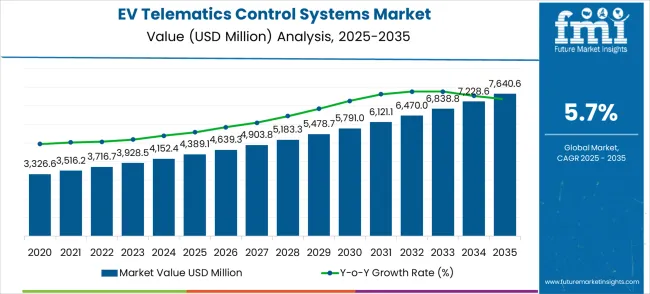
| Metric | Value |
|---|---|
| Market Value (2025) | USD 4,389.1 million |
| Market Forecast Value (2035) | USD 7,640.6 million |
| Market Forecast CAGR | 5.7% |
Between 2025 and 2030, when revenue expands from USD 4,389.1 million to USD 5,791.0 million, regulatory frameworks emphasize safety, connectivity standards, and data security. Governments in regions such as the EU, North America, and Asia-Pacific are increasingly mandating telematics systems for real-time vehicle tracking, diagnostics, and emergency response. Regulations related to cybersecurity, over-the-air (OTA) software updates, and interoperability with smart infrastructure become central to adoption. Compliance costs during this period are expected to rise, pushing manufacturers to integrate standardized telematics systems across vehicle platforms while ensuring affordability to meet regional policy guidelines.
From 2030 to 2035, as revenue grows from USD 5,791.0 million to USD 7,640.6 million, the regulatory impact shifts toward advanced integration with energy systems and autonomous mobility frameworks. Policies focused on vehicle-to-grid communication, fleet management efficiency, and zero-emission targets increase the reliance on sophisticated telematics control systems. Regulatory mandates on data privacy, cross-border telematics interoperability, and AI-driven predictive maintenance are expected to intensify, influencing design and deployment strategies. By 2035, regulations not only ensure compliance but also create competitive differentiation, as companies that adapt faster to evolving requirements gain stronger market positions in the global EV ecosystem.
Market expansion is being supported by the rapid increase in electric vehicle adoption worldwide and the corresponding need for advanced connectivity solutions that provide superior data transmission capabilities and vehicle monitoring reliability for next-generation automotive applications. Modern electric vehicles and fleet management systems rely on consistent connectivity and data integrity to ensure optimal vehicle performance including battery management, charging optimization, and predictive maintenance. Even minor connectivity inefficiencies can require comprehensive system adjustments to maintain optimal vehicle performance standards and operational efficiency.
The growing complexity of electric vehicle requirements and increasing demand for connected car solutions are driving demand for EV telematics control systems from certified manufacturers with appropriate performance capabilities and technical expertise. Vehicle operators are increasingly requiring documented performance specifications and reliability standards to maintain data transmission quality and operational efficiency. Industry specifications and performance standards are establishing standardized connectivity procedures that require specialized telematics technologies and trained automotive technical personnel.
The EV Telematics Control Systems market is entering a new phase of growth, driven by demand for connected vehicles, electric vehicle adoption, and evolving automotive technology and connectivity standards. By 2035, these pathways together can unlock USD 800-1,000 million in incremental revenue opportunities beyond baseline growth.
Pathway A -- System Architecture Leadership (Embedded Linux) The Embedded Linux segment already holds the largest share due to its superior flexibility and cost efficiency. Expanding customization capabilities, security enhancement, and integration efficiency can consolidate leadership. Opportunity pool: USD 200-250 million.
Pathway B -- Consumer Market Expansion (Private EV Owners) Private EV owners account for the largest demand. Growing consumer electric vehicle adoption, especially in emerging economies, will drive higher adoption of telematics control systems for vehicle management. Opportunity pool: USD 180-220 million.
Pathway C -- Commercial Fleet Integration (Fleet Operators) Fleet operators represent significant growth potential with increasing electrification. Systems optimized for fleet management applications can capture substantial growth. Opportunity pool: USD 150-190 million.
Pathway D -- Emerging Market Expansion Asia-Pacific and Latin America present growing demand due to rising electric vehicle adoption. Targeting cost-competitive solutions and local partnerships will accelerate adoption. Opportunity pool: USD 120-150 million.
Pathway E -- Autonomous Vehicle Integration With increasing autonomous vehicle development, there is an opportunity to promote telematics systems optimized for self-driving vehicle infrastructure. Opportunity pool: USD 80-100 million.
Pathway F -- Specialized Applications (Commercial & Industrial) Systems optimized for commercial vehicles, delivery fleets, and specialized transportation offer premium positioning for high-performance sectors. Opportunity pool: USD 40-50 million.
Pathway G -- Service Integration & Data Analytics Recurring revenue from data services, predictive maintenance, and advanced analytics creates long-term revenue streams. Opportunity pool: USD 20-30 million.
Pathway H -- Smart City Integration & IoT Connectivity Vehicle-to-infrastructure communication, smart traffic management, and IoT integration can elevate telematics systems into comprehensive urban mobility solutions. Opportunity pool: USD 10-20 million.
The market is segmented by system type, application, and region. By system type, the market is divided into Embedded Linux, Real-Time Operating Systems, and other system architectures. Based on application, the market is categorized into private EV owners, fleet operators, and other commercial applications. Regionally, the market is divided into North America, Europe, East Asia, South Asia & Pacific, Latin America, and Middle East & Africa.
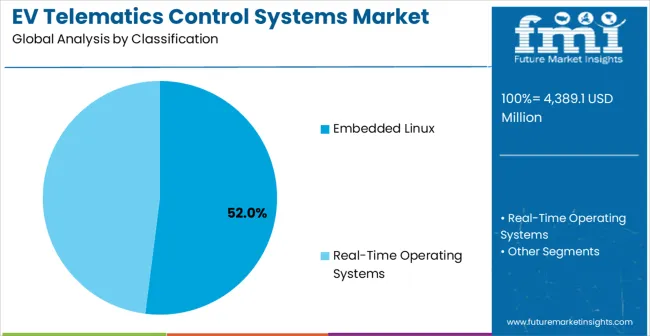
In 2025, the Embedded Linux system type segment is projected to capture around 52% of the total market share, making it the leading system architecture category. This dominance is largely driven by the widespread adoption of open-source solutions that provide optimal balance between cost efficiency and performance capability, catering to a wide variety of advanced automotive applications. Embedded Linux systems are particularly favored for their ability to deliver superior customization flexibility and scalability in both passenger vehicle and commercial fleet installations, ensuring system adaptability and future upgrade capabilities. Electric vehicle manufacturers, fleet management providers, telematics service companies, and connected car applications increasingly prefer this configuration, as it meets demanding connectivity requirements without imposing excessive licensing costs or development complexity. The availability of well-established development frameworks, along with comprehensive technical support options and standardized interfaces from leading suppliers, further reinforces the segment's market position.
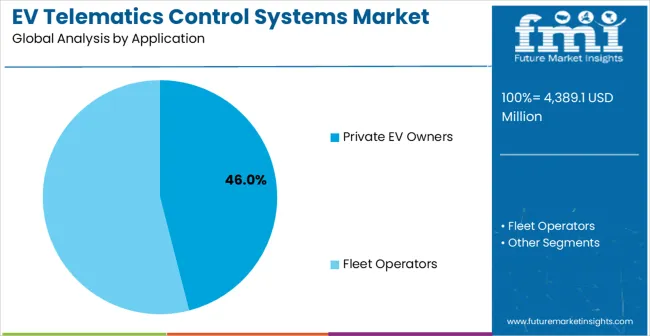
The private EV owners segment is expected to represent 46% of EV telematics control systems demand in 2025, highlighting its position as the most significant application sector. This dominance stems from the critical connectivity requirements of modern consumer electric vehicles, where real-time vehicle monitoring and smart charging management are essential to optimal driving experience and battery performance. Private EV owners often require comprehensive vehicle connectivity that demands specialized telematics systems throughout complex automotive architectures, requiring reliable and user-friendly connectivity solutions. EV telematics control systems are particularly well-suited to these applications due to their ability to provide consistent performance monitoring and battery optimization, even during intensive driving operations and varying usage patterns. As electric vehicle adoption expands globally and emphasizes improved user experience standards, the demand for EV telematics control systems continues to rise.
The segment also benefits from heightened digitalization requirements within the automotive industry, where consumers are increasingly prioritizing vehicle connectivity and smart features as essential purchase decisions.
The EV Telematics Control Systems market is advancing rapidly due to increasing electric vehicle adoption and growing recognition of connected vehicle advantages over traditional automotive systems in smart mobility applications. However, the market faces challenges including higher integration costs compared to conventional alternatives, need for specialized cybersecurity and data protection measures, and complex compatibility requirements with existing vehicle architectures across different automotive platforms. Performance optimization efforts and advanced connectivity technology programs continue to influence system development and market adoption patterns.
The growing development of advanced V2X communication protocols and enhanced connectivity systems is enabling superior data exchange capacity with improved real-time responsiveness and reduced latency issues. Advanced V2X technologies and optimized communication designs provide superior vehicle-to-infrastructure connectivity while maintaining integration flexibility requirements. These technologies are particularly valuable for fleet operators who require reliable connectivity performance that can support extensive vehicle monitoring operations with consistent real-time results.
Modern EV telematics control system manufacturers are incorporating advanced AI-driven analytics capabilities and intelligent predictive systems that enhance vehicle performance and operational effectiveness. Integration of machine learning algorithms and optimized data processing systems enables superior vehicle optimization and comprehensive fleet management capabilities. Advanced AI features support operation in diverse automotive environments while meeting various performance requirements and connectivity specifications.
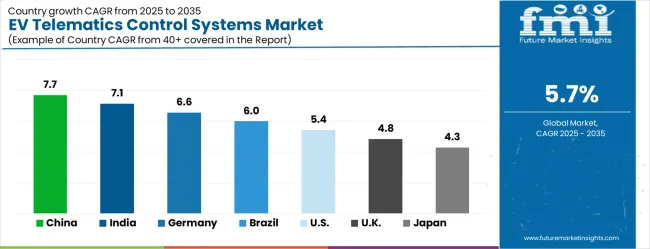
| Country | CAGR (2025-2035) |
|---|---|
| China | 7.7% |
| India | 7.1% |
| Germany | 6.6% |
| Brazil | 6.0% |
| United States | 5.4% |
| United Kingdom | 4.8% |
| Japan | 4.3% |
The EV telematics control systems market is growing rapidly, with China leading at a 7.7% CAGR through 2035, driven by massive electric vehicle adoption and increasing implementation of connected vehicle technologies. India follows at 7.1%, supported by rising electric vehicle infrastructure development and growing awareness of smart mobility benefits. Germany grows strongly at 6.6%, integrating advanced automotive technology into its established automotive manufacturing sector. Brazil records 6.0%, emphasizing electric vehicle infrastructure development and connectivity modernization initiatives. The United States shows solid growth at 5.4%, focusing on electric vehicle market expansion and smart transportation systems. The United Kingdom demonstrates steady progress at 4.8%, maintaining established automotive technology applications. Japan records 4.3% growth, concentrating on technology advancement and automotive efficiency optimization.
The report covers an in-depth analysis of 40+ countries top-performing countries are highlighted below.
China is expected to record the highest expansion in EV telematics control systems at a CAGR of 7.7% through 2035, driven by unprecedented expansion of electric vehicle adoption and increasing demand for connected vehicle solutions. The country's massive automotive sector and expanding charging infrastructure are creating enormous demand for advanced telematics system solutions. Major automotive manufacturers are establishing comprehensive connected vehicle networks to support the increasing requirements of electric vehicle companies and fleet operators across metropolitan regions.
Government electric vehicle development initiatives are supporting establishment of smart mobility systems and advanced automotive technology complexes, driving demand for high-performance telematics systems throughout major automotive zones. Automotive sector modernization programs are facilitating adoption of connected vehicle technologies that enhance vehicle connectivity and performance standards across electric vehicle networks.
India is witnessing expansion in EV telematics control systems at a CAGR of 7.1% through 2035, supported by increasing electric vehicle sector development and growing awareness of connected mobility benefits. The country's expanding automotive infrastructure and rising vehicle connectivity standards are driving demand for advanced telematics system solutions. Automotive companies and electric vehicle facilities are gradually implementing high-performance connectivity equipment to maintain competitive standards and operational efficiency.
Electric vehicle sector growth and automotive infrastructure development are creating opportunities for suppliers that can support diverse vehicle requirements and performance specifications. Professional training and technical programs are building expertise among automotive technical personnel, enabling effective utilization of telematics system technology that meets automotive standards and connectivity requirements.
Demand for EV telematics control systems in Germany is projected to grow at a CAGR of 6.6%, supported by the country's emphasis on automotive technology quality standards and advanced connected vehicle adoption. German automotive facilities are implementing sophisticated connectivity systems that meet stringent performance requirements and operational specifications. The market is characterized by a focus on vehicle reliability, data transmission excellence, and compliance with comprehensive automotive standards.
Automotive industry investments are prioritizing cutting-edge connectivity technology that demonstrates superior performance and reliability while meeting German quality and efficiency standards. Professional certification programs are ensuring comprehensive technical expertise among automotive personnel, enabling specialized connectivity capabilities that support diverse automotive applications and facility requirements.
Revenue from EV telematics control systems in Brazil is growing at a CAGR of 6.0%, driven by increasing electric vehicle infrastructure development and growing recognition of connected mobility advantages. The country's expanding automotive sector is gradually integrating advanced connectivity solutions to enhance vehicle performance and service quality. Automotive facilities and electric vehicle operators are investing in telematics technology to address evolving connectivity requirements and competitive pressures.
Electric vehicle infrastructure modernization is facilitating adoption of advanced connectivity technologies that support comprehensive vehicle capabilities across automotive regions. Professional development programs are enhancing technical capabilities among automotive personnel, enabling effective telematics system utilization that meets evolving automotive standards and performance requirements.
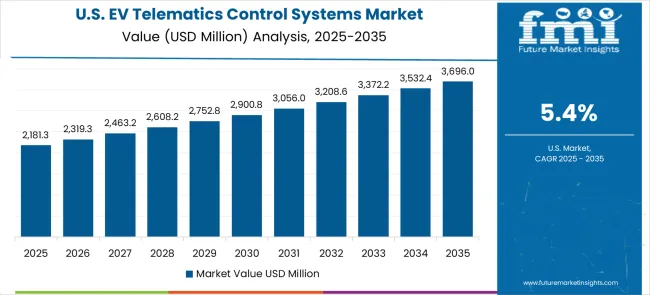
EV telematics control systems in the United States are forecasted to advance at a CAGR of 5.4% through 2035, driven by established automotive industries and growing emphasis on vehicle connectivity enhancement. Large automotive companies and electric vehicle providers are implementing comprehensive telematics system capabilities to serve diverse connectivity requirements. The market benefits from established automotive infrastructure distribution systems and professional development programs that support various automotive applications.
Automotive industry leadership is enabling standardized connectivity utilization across multiple vehicle types, providing consistent performance standards and comprehensive connectivity coverage throughout regional markets. Professional development and certification programs are building specialized technical expertise among automotive personnel, enabling effective telematics system utilization that supports evolving automotive facility requirements.
The United Kingdom is projected to record expansion in EV telematics control systems at a CAGR of 4.8% through 2035, supported by established automotive sectors and growing emphasis on vehicle connectivity capabilities. British automotive facilities and vehicle service providers are implementing telematics system solutions that meet industry performance standards and operational requirements. The market benefits from established automotive infrastructure and comprehensive training programs for technical professionals.
Automotive facility investments are prioritizing advanced connectivity solutions that support diverse vehicle applications while maintaining established performance and reliability standards. Professional development programs are building technical expertise among automotive personnel, enabling specialized telematics system operation capabilities that meet evolving facility requirements and performance standards.
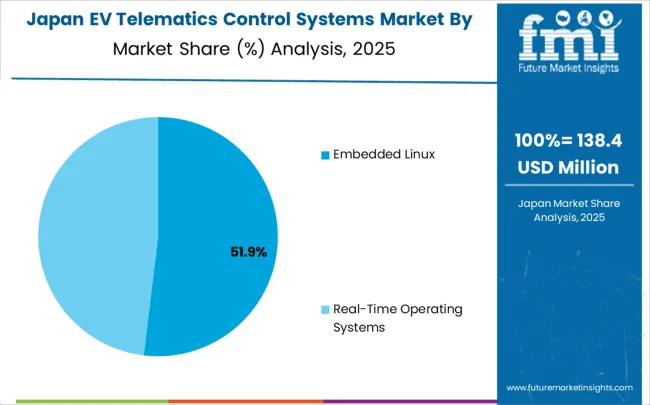
The EV telematics control system segment in Japan is anticipated to post a CAGR of 4.3% through 2035, driven by the country's focus on automotive technology innovation and vehicle enhancement applications. Japanese automotive facilities are implementing advanced telematics system solutions that demonstrate superior performance reliability and operational consistency. The market is characterized by emphasis on technological excellence, quality assurance, and integration with established automotive workflows.
Automotive technology investments are prioritizing innovative connectivity solutions that combine advanced telematics system technology with precision engineering while maintaining Japanese quality and reliability standards. Professional development programs are ensuring comprehensive technical expertise among automotive personnel, enabling specialized connectivity capabilities that support diverse automotive applications and facility requirements.
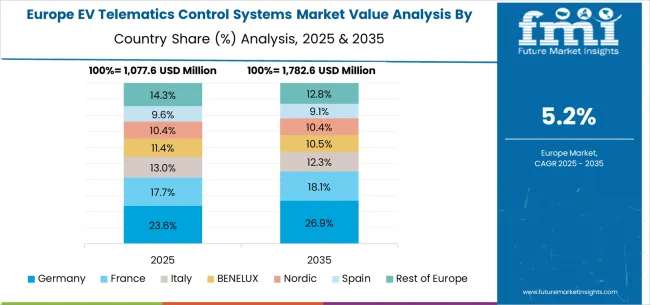
The EV telematics control systems market in Europe is forecast to expand from USD 1,145.2 million in 2025 to USD 1,996.8 million by 2035, registering a CAGR of 5.7%. Germany will remain the largest market, holding 29.8% share in 2025, easing to 29.2% by 2035, supported by strong automotive infrastructure and advanced connected vehicle standards. The United Kingdom follows, rising from 21.6% in 2025 to 22.1% by 2035, driven by automotive facility modernization and vehicle connectivity enhancement initiatives. France is expected to maintain stability from 18.2% to 17.9%, reflecting consistent automotive industry investments and connectivity requirements. Italy holds around 12.8% throughout the forecast period, supported by automotive facility upgrades and vehicle infrastructure modernization programs. Spain grows from 9.4% to 9.8% with expanding automotive infrastructure and increased focus on connected vehicle solutions. BENELUX markets maintain 4.6% to 4.4%, while the remainder of Europe hovers near 3.6%--3.6%, balancing emerging Eastern European automotive development against mature Nordic markets with established connected vehicle technology adoption patterns.
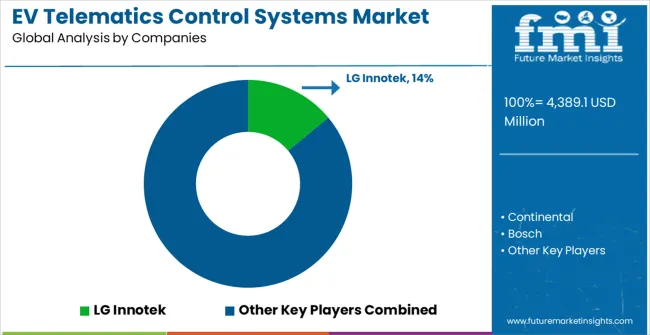
The EV telematics control systems market is defined by competition among specialized automotive technology manufacturers, connected vehicle solution companies, and telematics service providers. Companies are investing in advanced connectivity technology development, system integration innovation, vehicle performance optimization, and comprehensive service capabilities to deliver reliable, high-performance, and cost-effective telematics solutions. Strategic partnerships, technological innovation, and market expansion are central to strengthening product portfolios and market presence.
LG Innotek offers comprehensive automotive telematics solutions with established manufacturing expertise and professional-grade connectivity capabilities. Continental provides specialized automotive systems with a focus on vehicle reliability and operational performance. Bosch delivers advanced connectivity solutions with emphasis on performance efficiency and vehicle-friendly operation. HARMAN specializes in connected car technology with advanced integration capabilities.
Denso offers professional-grade automotive equipment with comprehensive technical support capabilities. Visteon delivers established automotive solutions with advanced telematics technologies. Aptiv provides specialized connectivity equipment with a focus on performance optimization. Valeo, Hitachi Astemo, Mitsubishi, Hyundai Marelli, Quectel, Teltonika Telematics, Ficosa, u-blox, Sierra Wireless, and CalAmp offer specialized manufacturing expertise, product reliability, and comprehensive development across global and regional automotive market segments.
| Item | Value |
|---|---|
| Quantitative Units | USD 4,389.1 million |
| System Type | Embedded Linux, Real-Time Operating Systems, Other System Architectures |
| Application | Private EV Owners, Fleet Operators, Other Commercial Applications |
| Regions Covered | North America, Europe, East Asia, South Asia & Pacific, Latin America, Middle East & Africa |
| Country Covered | China, India, Germany, Brazil, United States, United Kingdom, Japan, and 40+ countries |
| Key Companies Profiled | LG Innotek, Continental, Bosch, HARMAN, Denso, Visteon, Aptiv, Valeo, Hitachi Astemo, Mitsubishi, Hyundai Marelli, Quectel, Teltonika Telematics, Ficosa, u-blox, Sierra Wireless, CalAmp |
| Additional Attributes | Dollar sales by system type and application segment, regional demand trends across major markets, competitive landscape with established automotive technology manufacturers and emerging connectivity providers, customer preferences for different system configurations and performance options, integration with vehicle architectures and automotive protocols, innovations in connected vehicle technology and telematics efficiency, and adoption of advanced connectivity features with enhanced data capabilities for improved vehicle workflows. |
The global EV telematics control systems market is estimated to be valued at USD 4,389.1 million in 2025.
The market size for the EV telematics control systems market is projected to reach USD 7,640.6 million by 2035.
The EV telematics control systems market is expected to grow at a 5.7% CAGR between 2025 and 2035.
The key product types in EV telematics control systems market are embedded linux and real-time operating systems.
In terms of application, private EV owners segment to command 46.0% share in the EV telematics control systems market in 2025.






Our Research Products

The "Full Research Suite" delivers actionable market intel, deep dives on markets or technologies, so clients act faster, cut risk, and unlock growth.

The Leaderboard benchmarks and ranks top vendors, classifying them as Established Leaders, Leading Challengers, or Disruptors & Challengers.

Locates where complements amplify value and substitutes erode it, forecasting net impact by horizon

We deliver granular, decision-grade intel: market sizing, 5-year forecasts, pricing, adoption, usage, revenue, and operational KPIs—plus competitor tracking, regulation, and value chains—across 60 countries broadly.

Spot the shifts before they hit your P&L. We track inflection points, adoption curves, pricing moves, and ecosystem plays to show where demand is heading, why it is changing, and what to do next across high-growth markets and disruptive tech

Real-time reads of user behavior. We track shifting priorities, perceptions of today’s and next-gen services, and provider experience, then pace how fast tech moves from trial to adoption, blending buyer, consumer, and channel inputs with social signals (#WhySwitch, #UX).

Partner with our analyst team to build a custom report designed around your business priorities. From analysing market trends to assessing competitors or crafting bespoke datasets, we tailor insights to your needs.
Supplier Intelligence
Discovery & Profiling
Capacity & Footprint
Performance & Risk
Compliance & Governance
Commercial Readiness
Who Supplies Whom
Scorecards & Shortlists
Playbooks & Docs
Category Intelligence
Definition & Scope
Demand & Use Cases
Cost Drivers
Market Structure
Supply Chain Map
Trade & Policy
Operating Norms
Deliverables
Buyer Intelligence
Account Basics
Spend & Scope
Procurement Model
Vendor Requirements
Terms & Policies
Entry Strategy
Pain Points & Triggers
Outputs
Pricing Analysis
Benchmarks
Trends
Should-Cost
Indexation
Landed Cost
Commercial Terms
Deliverables
Brand Analysis
Positioning & Value Prop
Share & Presence
Customer Evidence
Go-to-Market
Digital & Reputation
Compliance & Trust
KPIs & Gaps
Outputs
Full Research Suite comprises of:
Market outlook & trends analysis
Interviews & case studies
Strategic recommendations
Vendor profiles & capabilities analysis
5-year forecasts
8 regions and 60+ country-level data splits
Market segment data splits
12 months of continuous data updates
DELIVERED AS:
PDF EXCEL ONLINE
EV Charger Tester Market Size and Share Forecast Outlook 2025 to 2035
EV Transmission System Market Size and Share Forecast Outlook 2025 to 2035
EV Charger Converter Module Market Forecast Outlook 2025 to 2035
EV Charging Panelboard Market Forecast Outlook 2025 to 2035
Evacuated Miniature Crystal Oscillator (EMXO) Market Forecast and Outlook 2025 to 2035
EV Charging Tester Market Size and Share Forecast Outlook 2025 to 2035
Evaporative Air Cooler Market Size and Share Forecast Outlook 2025 to 2035
EV Charging Cable Market Size and Share Forecast Outlook 2025 to 2035
EVOH Encapsulation Film Market Size and Share Forecast Outlook 2025 to 2035
eVTOL Charging Facilities Market Size and Share Forecast Outlook 2025 to 2035
Event Tourism Market Size and Share Forecast Outlook 2025 to 2035
Evidence Collection Tubes Market Size and Share Forecast Outlook 2025 to 2035
EV Battery Recycling and Black Mass Processing Market Analysis - Size, Share, and Forecast Outlook 2025 to 2035
EVA Coated Film Market Size and Share Forecast Outlook 2025 to 2035
EV Charging Management Software Platform Market Size and Share Forecast Outlook 2025 to 2035
EV EMC Battery Filter Market Size and Share Forecast Outlook 2025 to 2035
EV Traction Inverter Market Size and Share Forecast Outlook 2025 to 2035
EV Plant Construction Market Size and Share Forecast Outlook 2025 to 2035
EV Battery Heating System Market Size and Share Forecast Outlook 2025 to 2035
EV Charging Station Market Analysis - Size, Share, and Forecast Outlook 2025 to 2035

Thank you!
You will receive an email from our Business Development Manager. Please be sure to check your SPAM/JUNK folder too.
Chat With
MaRIA